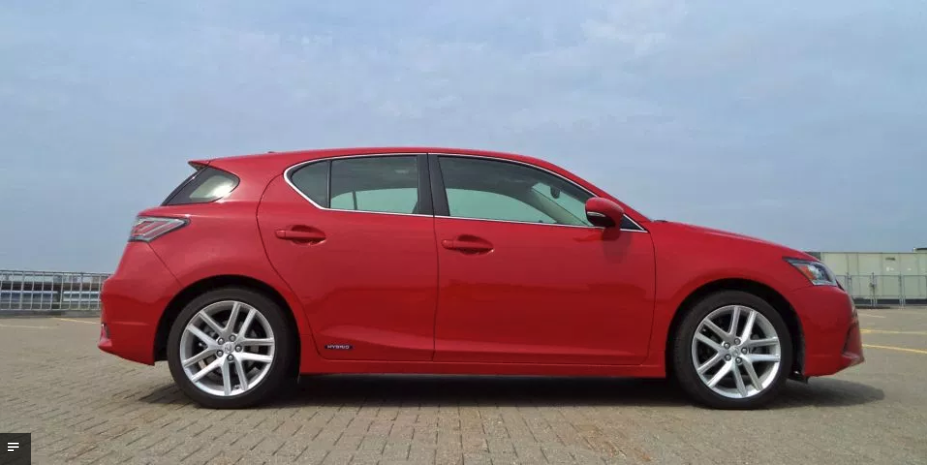Road Test: 2014 Lexus CT 200h

Story and photo by John LeBlanc
Right off the bat, the Lexus CT 200h has had two things going for it since its arrival for 2011.
First, as a premium gasoline-electric hybrid compact hatchback, it’s truly a one-of-a-kind proposition in a market that’s full of copycats.
Second, the CT 200h is not the Lexus HS 250h.
Do you remember the HS? It was the Toyota luxury brand’s first attempt at a premium compact hybrid. Like the hatchback CT, the sedan HS was based on the European Toyota Avensis platform. But the hybrid’s frumpy styling, tight rear quarters (it had less rear legroom than a Corolla), ambitious pricing ($40,000 to $50,000) and lack of driving refinement had buyers staying away in droves. After two years on the market, Lexus killed the HS for 2012, wisely replacing it with the more conventional and capable mid-size Lexus ES 300h sedan for 2013.
That left Lexus with the CT 200h as its entry-level model — a definite improvement over the HS 250h. Cynics may see the Lexus front-wheel-drive, five-passenger, four-door hatchback as a slightly less functional, slightly less frugal version of the Toyota Prius Liftback (the CT 200h uses the same 1.8 L four-cylinder gas engine, electric motor, and CVT hardware). However, the Lexus’s flashier styling and the premium interior more than makeup for its $5,220 premium (all starting prices include freight and pre-delivery inspection fees) over the $27,725 Toyota hybrid hatch.
As 2014 marks its fourth year on sale, the CT 200h gets some mid-cycle updates. Keen observers will notice it now sports the brand’s gaping “signature Spindle Grille,” plus new front and rear bumpers, aero-stabilizing fins, rear spoiler, “shark-fin” antenna and LED license plate lamps. Inside, the CT 200h gets a new steering wheel, CVT shift lever, tire pressure monitoring system and the ability to turn off its Traction Control system for “more direct control on closed tracks,” according to Lexus.
One of the best qualities of the compact CT 200h is its interior design. It may be the so-called “baby Lexus”, but its cabin feels all grown up. The quality of the leather seating surfaces (part of a $6,800 Premium Package that also included such niceties as a power moonroof and backup camera, among other details) and tight fit and finish of its soft-touch plastics help justify the Lexus hybrid’s extra costs over the less expensive Toyota hybrid.
Although its hatchback body offers a modicum of practicality and room (by placing the CT 200h’s nickel-metal-hydride battery pack between the car’s rear wheels, there’re 405 litres of rear cargo room) the Lexus’s rear seat legroom is not NBA-sanctioned. The 200h has seatbelts for five, but four will be happier. And combined with its angled back rear roofline, getting packages or children in and out of the rear seats may require more athleticism than buyers were expecting.
What CT 200h buyers can expect is outstanding fuel economy. The CT 200h is rated at 4.5 litres per 100 kilometres in the city, 4.8 on the highway. After a week of almost exclusive urban driving, I saw an average of 6.8 L/100 km.
Of course, such frugality comes at a cost. And in the Lexus’s case, that’s straight-line acceleration. With only 134 horsepower onboard, it takes 10.5 seconds to go from zero to 100 kilometres per hour. Trust me: that’s slow. And that’s even when you select the CT 200h’s Sport Mode that adds more boost from the electric motor and sharper gas pedal reaction. (As long as the batteries are charged up, Sport Mode is also useful for merging onto highways.) However, the power delivery is like an “on/off” switch, without the type of linear acceleration found in rival luxury compacts.
The CT 200h looks and feels more sporty and upscale than the Prius. But to appeal to buyers also considering some European premium compacts, Lexus has also tried to make its hybrid hatchback drive differently than the Toyota. But the result won’t have CT 200h owners chasing down a BMW 2 Series or Audi A3 Sportback on a twisty back road. In an attempt to deliver a more athletic handling package, the CT 200h gets stiffer springs and shock absorbers than the Prius. However, the Lexus’s ride quality ends up quite brittle on anything but the smoothest pavement.
For small car buyers who spend the majority of their time on congested urban roads, the 2014 CT 200h is a highly fuel-efficient fortress of solitude. Driven less aggressively, it becomes the relaxed Lexus luxury car buyers were expecting. The lack of wind and road noise created by additional cabin insulation gives the feeling that you’re driving a much larger car, but with the fuel economy of a Prius. For many buyers, that will be reason enough to buy one.
WHAT I LIKED: Sharp shape; premium interior; excellent economy.
WHAT I DIDN’T: E-scooters may beat the Lexus at stoplights; wooden handling doesn’t match its sexy looks.
Type of vehicle Front-wheel-drive compact coupe
Engine 1.8 DOHC four-cylinder gas engine + electric motor
Power 134 hp combined
Transmission Continuously variable automatic transmission
Brakes Four-wheel disc with ABS
Tires P215/45R 17
Price (base/as tested) $30,950/$37,750
Destination charge $1,995
Natural Resources Canada fuel economy (L/100 km) 4.5 city, 4.8 highway, 6.8 as-tested
Options $6,800 Premium Package (reverse auto-tilting exterior mirrors; auto-dimming side view mirrors; driver seat memory system; leather seat surfaces; 17-inch aluminum alloy wheels; rain-sensing wipers; 10-speaker Lexus Display Audio system; Display Audio Controller; garage door opener; power moonroof; backup camera; LED fog lights; LED headlamps; mirrors linked to seat memory; and more.)





![[del.icio.us]](https://www.straight-six.com/wp-content/plugins/bookmarkify/delicious.png)
![[Digg]](https://www.straight-six.com/wp-content/plugins/bookmarkify/digg.png)
![[Facebook]](https://www.straight-six.com/wp-content/plugins/bookmarkify/facebook.png)
![[Google]](https://www.straight-six.com/wp-content/plugins/bookmarkify/google.png)
![[Reddit]](https://www.straight-six.com/wp-content/plugins/bookmarkify/reddit.png)
![[StumbleUpon]](https://www.straight-six.com/wp-content/plugins/bookmarkify/stumbleupon.png)
![[Twitter]](https://www.straight-six.com/wp-content/plugins/bookmarkify/twitter.png)
![[Email]](https://www.straight-six.com/wp-content/plugins/bookmarkify/email.png)